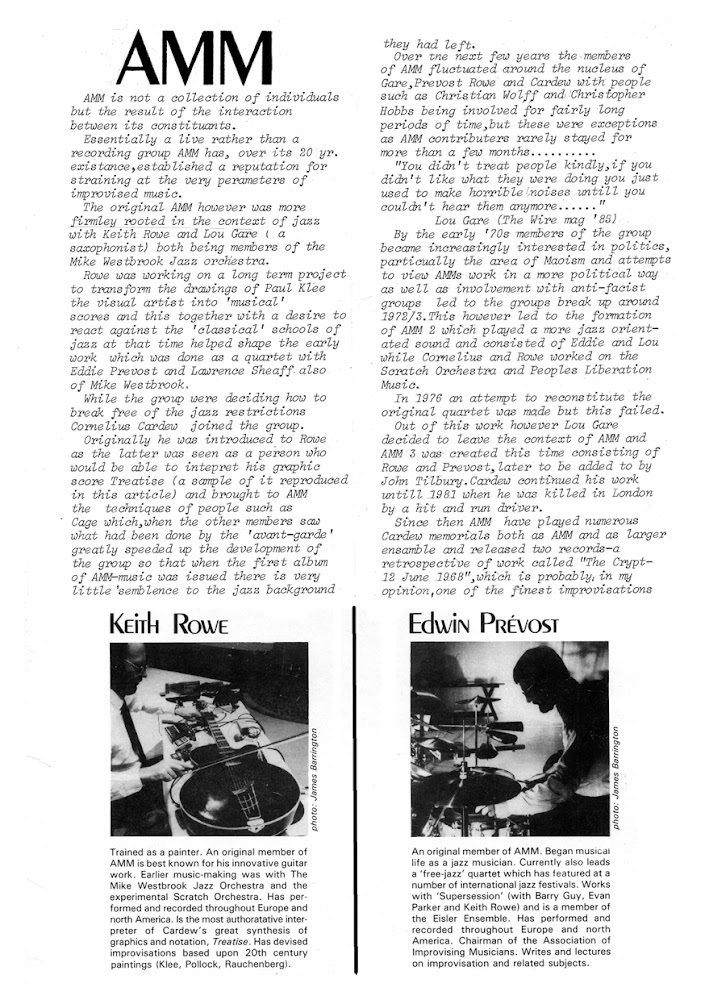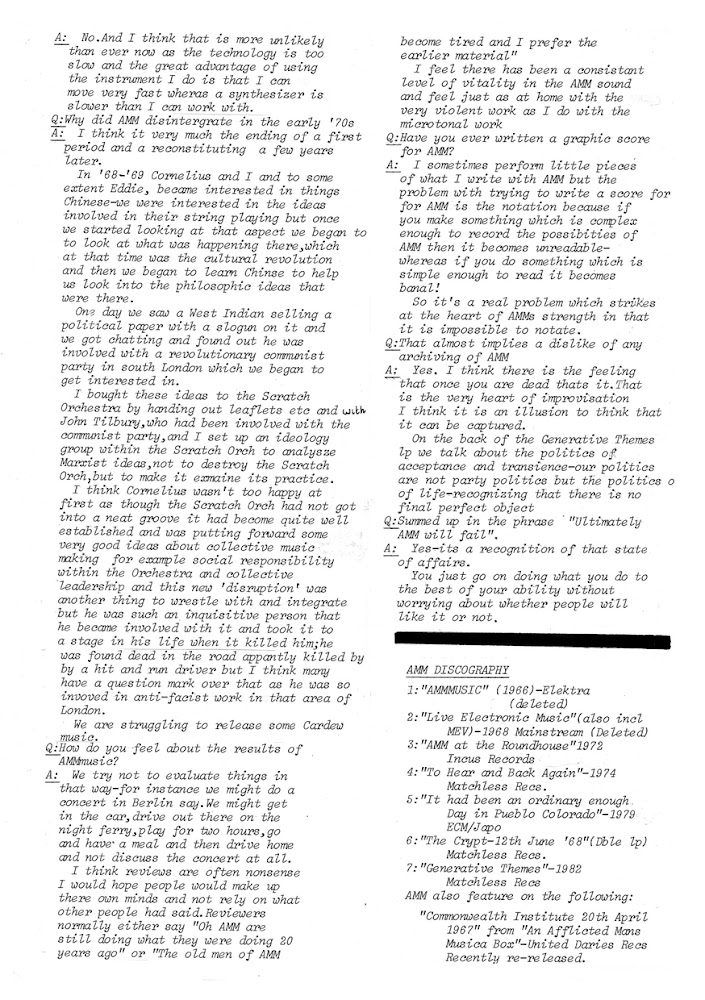INTERCHANGE MAGAZINE
Interchange was a magazine dedicated to electronic and experimental music that ran for four issues between 1982-1986. These postings reproduce all the issues, made from scans of the original masters, together with a few anecdotes regarding how each one came into existence. The online images are low resolution but you can also print out your own copy of the magazine via a link to a hi-res PDF.
A short piece on the genesis of the magazine and scans of Interchange 1 can be found HERE. Interchange 2 is HERE and Interchange 4 HERE.
There were also three cassette releases. A c90 compilation tape Inter 01, a c60 by The Adventures Of Twizzle, The Great Waster and a c46 by Ward Phillips, Cyclades. I discuss (and post the artwork for) The Great Waster HERE). The Ward Phillips link HERE will take you to the artwork and within that piece, another link to the music itself.
INTRODUCTION TO ISSUE 3
I had also long been corresponding with Tim Gane of Un-Kommuniti (they later became Stereolab) mainly over our joint interest in writer H.P. Lovecraft. Lovecraft (minus his racism) was hugely influential on my outlook at the time and Andrew Lawson’s ‘Poe Night’ (Lawson was part of our tight knit group in Newcastle) captures something of that zeitgeist.
I was very happy to have the piece on Dark Star by Peter Harrison. Harrison had a truly encyclopaedic knowledge of electronic music and was a regular contributor to many of the experimental/electronic music fanzines of the period.
Interchange 3 lists a few cassettes for sale; ‘The Inter 01’ compilation, ‘The Great Waster’ by The Adventures Of Twizzle and ‘Cyclades’ by Ward Phillips. The latter was the pseudonym of myself. All these releases will be discussed in subsequent posts.
This issue was printed locally. The John Marley Centre was formally a school, but had recently re-opened as a community resource centre with workshops, a gym and, incredibly, an offset press. Interchange 3 was, I think, the first thing of any substantial size produced there.
I also notice that I credit Northern Arts (the then Regional Arts Board). I must have got some money from them somehow (I was beginning to move a little more in the art world) but cannot recall it at all!
‘Interchange 3’ was the largest magazine I produced. It was split into two sections and featured a diverse range of artsits from AMM to Whitehouse.
A number of the artists in this issue had already appeared in the mainstream music paper ‘Sounds’ This was via a semi-regular column by Dave Henderson begun in mid 1983 called ‘Wild Planet’. It did not only cover ‘experimental’ music, but did list many artists, small labels, magazines (including ‘Interchange’) and distributors with leanings towards the weirder end of the musical spectrum.
Definitely not covered was the label ‘Come Organisation’ and their main artist Whitehouse. This label/band often re-appropriated fascist imagery and their uncompromising albums resulted in them being viewed with some suspicion. I had always got on very well with William Bennet via mail and he was just as nice in person. I had once gone to the post box address on Kensington Hight Street (what did I know?) which was only a short walk from Kensington Market, the home of Produktion Hair. This was a hairdressing salon (if you can call a market space about 15 feet square a 'salon') and always devoid of customers. I didn't get a haircut but they did have a few boxes of cassettes for sale which I perused and finally selected the Fistfuck release, purely on the basis that it was a good name - its was actually a great tape.
When William and I did meet, the interview was partly conducted in person at a Highgate pub (after a quick trip to see Dennis Nilsen’s house) and then followed up by further exchanges by mail.
Come Organisation and Broken Flag (run by Gary Mundy) were by far the most influential labels in the ‘Power Electronics’ scene. Broken Flag produced excellent compilations of noise works from a wide variety of artists including Mundy’s own influential group Ramleh. I corresponded with him for many years and would later contribute to Broken Flag’s magazine ‘Even When It Makes No Sense’.
The major interview in Pt. B is with AMM. In late ’82 I had attended a workshop they had led at Spectro Arts Centre (Newcastle) and later witnessed their evening performance. I had been very struck by their ability to interact with each other and the various subtle shifts of power between them. The actual interview was not conducted until much later (early 1985), the day after another performance of theirs in London.
AMM had played on Sunday, but the day before I had seen an extraordinary joint performance by Diamanda Galas and Test Department at the Albany Theatre in Deptford. I was not a big Test Dept. fan (even less Einstürzende Neubauten) but Galas was a different story; her album ‘The Litanies Of Satan’ is still an incredible record.
Technical issues during the event meant that both Galas and T.D. were angry and frustrated and this had fuelled their performance. When I interviewed her next day I was hung-over and had hardly slept (I had nowhere to stay so had roughed it in an abandoned basement) and Galas seemed weary. Perhaps this influenced our conversation.
I wanted to include Alvin Lucier after having heard ‘I am sitting in Room’ in which the harmonics of a room overtake the initial words spoken within it. His record company ‘Lovely’ kindly acted as go-between for me.
Of the others artists in the magazine, most had got in touch via earlier issues of the magazine (Esplendor Geometrico, XX Committee) or through mutual friends. Some were actually friends of long standing - The Brides Of Christ II being partly Rock Wilson’s of ‘Apocalypso Agogo’s band.
A number of the artists in this issue had already appeared in the mainstream music paper ‘Sounds’ This was via a semi-regular column by Dave Henderson begun in mid 1983 called ‘Wild Planet’. It did not only cover ‘experimental’ music, but did list many artists, small labels, magazines (including ‘Interchange’) and distributors with leanings towards the weirder end of the musical spectrum.
Definitely not covered was the label ‘Come Organisation’ and their main artist Whitehouse. This label/band often re-appropriated fascist imagery and their uncompromising albums resulted in them being viewed with some suspicion. I had always got on very well with William Bennet via mail and he was just as nice in person. I had once gone to the post box address on Kensington Hight Street (what did I know?) which was only a short walk from Kensington Market, the home of Produktion Hair. This was a hairdressing salon (if you can call a market space about 15 feet square a 'salon') and always devoid of customers. I didn't get a haircut but they did have a few boxes of cassettes for sale which I perused and finally selected the Fistfuck release, purely on the basis that it was a good name - its was actually a great tape.
When William and I did meet, the interview was partly conducted in person at a Highgate pub (after a quick trip to see Dennis Nilsen’s house) and then followed up by further exchanges by mail.
Come Organisation and Broken Flag (run by Gary Mundy) were by far the most influential labels in the ‘Power Electronics’ scene. Broken Flag produced excellent compilations of noise works from a wide variety of artists including Mundy’s own influential group Ramleh. I corresponded with him for many years and would later contribute to Broken Flag’s magazine ‘Even When It Makes No Sense’.
The major interview in Pt. B is with AMM. In late ’82 I had attended a workshop they had led at Spectro Arts Centre (Newcastle) and later witnessed their evening performance. I had been very struck by their ability to interact with each other and the various subtle shifts of power between them. The actual interview was not conducted until much later (early 1985), the day after another performance of theirs in London.
AMM had played on Sunday, but the day before I had seen an extraordinary joint performance by Diamanda Galas and Test Department at the Albany Theatre in Deptford. I was not a big Test Dept. fan (even less Einstürzende Neubauten) but Galas was a different story; her album ‘The Litanies Of Satan’ is still an incredible record.
Technical issues during the event meant that both Galas and T.D. were angry and frustrated and this had fuelled their performance. When I interviewed her next day I was hung-over and had hardly slept (I had nowhere to stay so had roughed it in an abandoned basement) and Galas seemed weary. Perhaps this influenced our conversation.
I wanted to include Alvin Lucier after having heard ‘I am sitting in Room’ in which the harmonics of a room overtake the initial words spoken within it. His record company ‘Lovely’ kindly acted as go-between for me.
Of the others artists in the magazine, most had got in touch via earlier issues of the magazine (Esplendor Geometrico, XX Committee) or through mutual friends. Some were actually friends of long standing - The Brides Of Christ II being partly Rock Wilson’s of ‘Apocalypso Agogo’s band.
I had also long been corresponding with Tim Gane of Un-Kommuniti (they later became Stereolab) mainly over our joint interest in writer H.P. Lovecraft. Lovecraft (minus his racism) was hugely influential on my outlook at the time and Andrew Lawson’s ‘Poe Night’ (Lawson was part of our tight knit group in Newcastle) captures something of that zeitgeist.
I was very happy to have the piece on Dark Star by Peter Harrison. Harrison had a truly encyclopaedic knowledge of electronic music and was a regular contributor to many of the experimental/electronic music fanzines of the period.
Interchange 3 lists a few cassettes for sale; ‘The Inter 01’ compilation, ‘The Great Waster’ by The Adventures Of Twizzle and ‘Cyclades’ by Ward Phillips. The latter was the pseudonym of myself. All these releases will be discussed in subsequent posts.
This issue was printed locally. The John Marley Centre was formally a school, but had recently re-opened as a community resource centre with workshops, a gym and, incredibly, an offset press. Interchange 3 was, I think, the first thing of any substantial size produced there.
I also notice that I credit Northern Arts (the then Regional Arts Board). I must have got some money from them somehow (I was beginning to move a little more in the art world) but cannot recall it at all!
A NOTE ON THE SCANS.
The scans are made from the original masters. In making them I was in a quandary over what to do about various images which in the original magazine reproduced poorly. For this version I have, where possible scanned the originals and re-inserted them. It then begged the question as to whether I should ‘neaten up’ my Biro drawn lines, remove paste up marks or realign bits of skewed text. I have decided against this as I did not want to sanitise the look of the original, but have adjusted some of text to make it more legible. The online images are low resolution, but you can print out your own copy of the magazine via the compressed hi-res PDFs. Part A is HERE. Part B is HERE.
INTERCHANGE 3 A
INTERCHANGE 3 B




























































